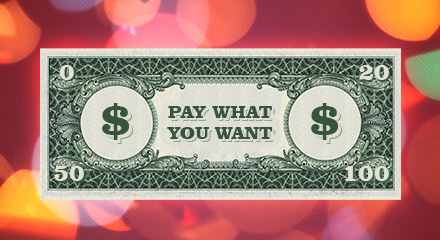We, western consumers, are used to the fixed price system; unless one ventures into the Chinatown of their city or deals with a flexible contractor, there is seldom space for negotiating prices, let alone be allowed to pay what we want. The Pay-What-You-Want model has however gained some popularity in the past few years, especially online where the Name-Your-Price option is more and more frequent.
Although it may sound like a bad idea at first to allow consumers to set the price themselves, this pricing option does work in several instances. There are stories of success and this model may well be the future of pricing for several business models. But where exactly does this model works best?
Where the Pay-What-You-Want model works well
The Pay-What-You-Want model relies on the consumer’s judgement and generosity, and it can be applied in various ways. In some cases a minimum price is set, in others there is no floor price; the product or service is then offered for free. Funding platforms like Kickstarter and Indiegogo provide suggested price brackets and in several occasions the received good varies in accordance to the amount of money given.
The Name-Your-Price model can be very attractive to consumers; unafraid to be disappointed by a price set in stone, they can pay what they sincerely believe the service or product is worth. Any money they willingly pay which is over the minimum suggested price is felt as a donation and it makes them feel good. As demonstrated by author Linda Formichelli in a Case Study about the Pay-What-You-Want method, this model can bring great results especially if the audience is accustomed to and likes the product/service offered.
This pricing system works best when the product offered has a low marginal cost, can credibly be sold at a wide range of prices and when there is a pre-established relationship between the buyer and seller. The clientèle also has to be inclined to accept the terms of fair-pay.
Concrete examples of areas where this model can be successful include but are not limited to: buying music, books and ebooks, courses and workshops (live or online), charity-based campaigns, software and, in some cases, restaurants. Products or services which would be created, distributed and/or performed regardless of price can greatly benefit from this pricing option.
Where it doesn’t work so well
The Pay-What-You-Want model, however great, does not work smoothly in all domains.
Selling high-priced products will probably not bare good results with this model; when there is no floor price, the seller can lose significant amounts of money and when there is a minimum set price, the consumers, because of the high value of the item, may not be willing to pay more than the (already relatively high) price asked.
Business models based on time rates (i.e. consulting, marketing services, etc.) are also less likely to succeed with this model. Unlike a tangible product or service which is concrete, time is abstract and harder to evaluate if one is not accustomed to the line of work. Indeed, if you asked someone to evaluate the “ideal” salary to be given to a consultant who has spent the last few weeks providing advice in regards to the growth of their company, they would probably not know where to begin. How much is advice and knowledge worth? The answer is subjective and can fluctuate greatly according to the buyer’s perception and the results achieved (assuming they can be appreciated in the short term, which is not always the case). That is why in these cases an hourly rate or cost per project (which usually takes into account estimated hours to be worked) is the method of choice.
Conclusion
The Pay-What-You Want pricing method is a bit risky but it can bring surprising results in several spheres. Besides inviting the buyer to participate in the pricing decision, it also helps to build stronger relationships between sellers and consumers. This model also allows all buyers to purchase items more easily at prices corresponding to the state of their finances.
In the spirit of fairness and accessibility, this system is a good one.
Have you tried it? What do you think of it? We invite you to share your views and experiences.
